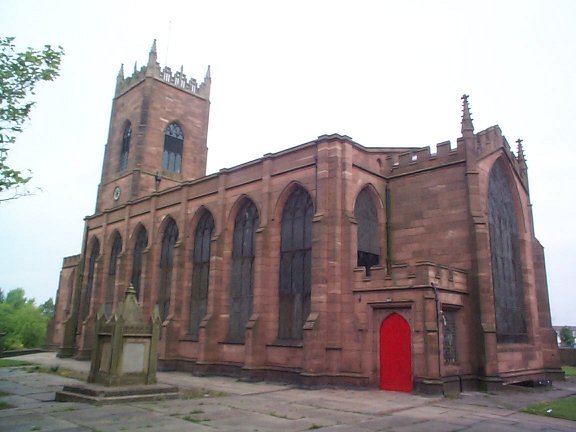 |
The
Parish of St George, Everton |
 |
St. George's Church, Everton
1814 - 1982
 | |
In the first years of the 19th century Everton was the '...exclusive abode of the rich and well-to-do...' and there were '...no dwellings of the poor or working classes in the neighbourhood....'. Everton had, however, no church of its own, the nearest being the parish church of Walton or West Derby or St. Anne's, Richmond. On the evening of 29th December 1812 a meeting of 'the inhabitants of Everton' was held at Halliday's Coffee House in Everton Village. The meeting resolved that 'a Church be built in Everton' and that this church be built by 'subscription to consist of 100 shares at £100 each'. A local resident, James Atherton, was to provide some capital and the site for the church.
In 1813 the St. George's Church, Everton Act was passed. The foundation stone of the church was laid on 19th April 1813 and the church was consecrated by the Bishop of Chester on 26th October 1814. The sale of pews to the Church 'Proprietors' was held in the St. George's Coffee House, Everton, on Friday 28th October and Divine Service was held for the first time on Sunday 30th October. The sale of pews to the 'public' took place on Monday 31st October. The new minister to the church or, it being in effect privately owned, 'chaplain' to the 'proprietors' was the Reverend Robert Pedder Buddicom, son of Robert Buddicom, who with James Atherton, was one of the two major shareholders in the church.
The design of the church had been discussed at the first meeting of 29th December 1812. Its architect was Thomas Rickman (1776 - 1841) who attended the meeting. He had come to Liverpool from the south in 1807 He became friendly with John Cragg (1767 - 1854) ironmaster and proprietor of the Mersey Iron Foundry who was 'fanatical about the use of cast iron'. The two continued what appears to have been a sometimes uneasy collaboration in the design and building of St. George's. The outer shell of the church was built in stone - '...the said Church and the Walls of the Cemetery of the same shall be built of Stone...' (see 1813 Act) but the interior was '...entirely in cast iron. Prefabricated columns, vaulting ribs, panels and window tracery were all transported from Cragg's foundry and bolted together inside the church' influenced in design by 'Rickman's meticulous analysis of Gothic architecture'. It was the first of Liverpool's 'iron churches'.
In the second half of the 19th century social changes in the Everton neighbourhood gave rise to serious financial problems for St. George's. Many of the Proprietors had left Everton and '..there were problems in obtaining the minister's stipend from the ground-rents and many pews were not let'. Under the incumbency, 1877 - 1882, of the Rev. William Trench, the control of the Church passed from the 'Proprietors' to the Ecclesiastical Commissioners. The Church was '...made over by its proprietors to the Ecclesiastical Commissioners for England, to the intent that all the seats should be forever henceforth maintained free and unappropriated for the use of all the parishioners'. Parochial boundaries were defined by the Ecclesiastical Commissioners and the Rev. William Woodward, incumbent for 1883 - 1891 could rightly be called the first Vicar of St. George's Parish, Everton.
Details of gravestone inscriptions in St. George's Church and graveyard are given in the following:-
D.E. Gardner (comp.) 'Monumental inscriptions in the churchyard of St. George's, Everton,' compiled 1939, typescript in 'Liverpool & District Epitaphs', Vol. 3, pp. 83 - 135.
J. Gibson, 'Epitaphs from St. George's Church... and Graveyard' in 'Epitaphs and Inscriptions...' , Vol. 4, pp. 457 - 547.
The following, on which the above notes are based, are useful sources for the history of St. George's, Everton:-
'An Act for erecting a Church in the Township of Everton, in the Parish of Walton on the Hill, in the County of Lancashire', 35 Geo. III, cap. 114, 3 Jun. 1813.
H. G. Hampson, 'History of St. George's Church, Everton', 1896.
Quentin Hughes, 'Seaport', 1964, pp. 137 - 141.
R. F. Mould, 'The Iron Church: St. George's Church, Everton', 1977.
'Thomas Rickman' in H. M. Colvin, 'Biographical Dictionary of English Architects 1660 - 1840', 1954, pp. 498 - 501.
Text courtesy of Liverpool Record Office, Liverpool Libraries.
Source
| Repository: | Liverpool Record Office |
| Ref No | 283 GEV |
| Accession No | 4361 |
| Extent | 81 volumes, 1 box, 1 folder |
| Registers: | |
| Baptisms | 1814 - 1967 |
| Marriages | 1814 - 1982 |
| Burials | 1815 - 1932 |
| Banns | 1920 - 1980 |
| Liverpool Home & Contents | ©Lancashire OnLine Parish Clerks | Lancashire Home |